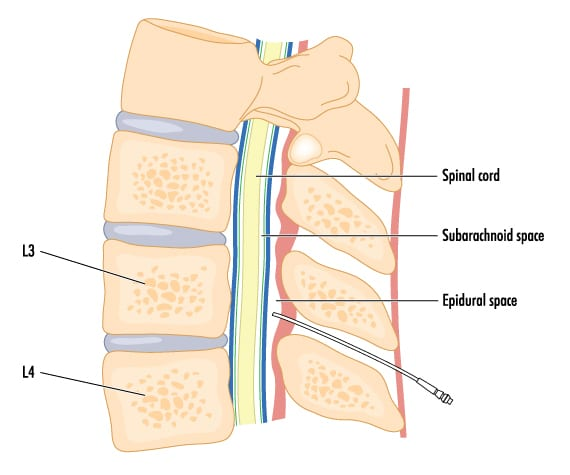Spinal blocks and epidurals are both used as pain relief in labour and childbirth, but they can also be used to treat painful back and spine conditions.
There are several differences between a spinal block vs epidural. In childbirth, a spinal block completely numbs the body from the chest down, while an epidural can be adjusted to provide different levels of pain relief. But both are also used to administer anaesthetic and other medications to treat chronic pain conditions.
Here, we’ll explore the differences between spinal block vs epidural for various medical procedures, so you can make an informed decision about your pain relief options.
Table of Contents
- What is an epidural and when is it used?
- What is a spinal block and when is it used?
- What’s the difference between an epidural vs a spinal block?
- Spinal block: pros and cons
- Epidural: pros and cons
- Spinal block vs epidural for specific health conditions
- Is a spinal block or epidural more painful?
- Get the best back pain treatment at Harley Street Specialist Hospital
What is an epidural and when is it used?
An epidural is a type of pain relief that’s injected into your back. It may be used to administer pain relief for childbirth, steroid injections for back and spine conditions like sciatica or a herniated disc, and painkilling drugs for cancer patients.
When you have an epidural, the needle is inserted into the epidural space of your spine: a hollow gap between the spinal cord and the vertebral arches.

When an epidural is used in labour, cancer, surgery, or trauma, the needle inserts an epidural catheter into the spine. Medicine can then be given directly into the epidural space via the catheter whenever it needs topping up.
However, if an epidural injection is used to administer a single dose of steroids for back pain management, a catheter isn’t necessary.
What is a spinal block and when is it used?
A spinal block is a similar procedure to an epidural, but the needle injects the anaesthetic medication into the space surrounding the spinal canal (the subarachnoid space). This allows the anaesthetic to target and numb specific areas of the body.

A total spinal block will leave you unable to move or feel your body until the anaesthetic wears off after a couple of hours. So spinal blocks are usually reserved for caesarean section and other relatively short operations involving the lower abdomen, pelvis, and lower extremities.
What’s the difference between an epidural vs a spinal block?
Spinal blocks provide more complete pain relief than epidurals, but can only be used for short procedures, while epidurals can provide much longer pain relief. In one comparative study, researchers found that 79.2% of spinal block patients were satisfied with their treatment, versus 70.5% of epidural patients [1].
But while epidurals and spinal blocks have similar purposes, they’re often used in different circumstances. So it’s not a case of which is better, but which is more suitable for you.
This table compares the differences between a spinal block vs epidural:
| Comparison | Spinal block | Epidural |
|---|---|---|
| Uses | Childbirth (caesarean section) Orthopaedic surgery (such as knee or hip replacements) Genital operations | Childbirth (vaginal delivery) Chronic back pain relief Cancer pain relief Postoperative pain management |
| Potential side effects | Headache Difficulty urinating Itchiness Shivering Nausea | Low blood pressure Loss of bladder control Itchiness Nausea Intense headache (in rare cases) |
| Results | Numbness from the armpits to the toes (total spinal block), or in a specific region of the body (selective nerve root block). | Depends on the medication. Epidurals in childbirth result in numbness around the lower body (possibly also affecting the chest and arms). Dose can be adjusted to allow more or less sensation in the body. Anaesthetic and/or epidural steroid injections for other types of pain relief result in short-term numbness and medium- to long-term reduction in inflammation. |
| Onset and duration | A fast-acting single-dose anaesthetic that takes effect within five minutes on average [1]. Effects wear off within 1-2 hours. | Takes up to 30 minutes for medication to take effect. Can be topped up or provided continuously to extend pain relief as needed. |
| Recovery | You’ll start to regain feeling in your legs within four hours. Post-procedure monitoring is needed in hospital. | If used for childbirth, recovery is similar to a spinal block. If used for administering steroids, you’ll be advised to rest after a cortisone injection for a few days to allow the medication to take effect. |
Spinal block: pros and cons
The benefits of a spinal block include:
- Rapid onset.
- Fewer side effects than general anaesthesia.
- Faster recovery than general anaesthesia.
- Option for total numbness and pain relief.
- Higher satisfaction rates among women in childbirth.
The disadvantages of a spinal block include:
- It’s not suitable for delivering corticosteroids (anaesthesia only).
- Total loss of sensation means longer recovery time.
- Headache is more likely than with an epidural.
- Dose can’t be adjusted.
Epidural: pros and cons
The benefits of an epidural injection include:
- Multiple uses (can deliver anaesthetic, steroids, and other medication).
- Can be topped up as often as needed to provide ongoing pain relief.
- Dose can be adjusted to increase or decrease sensation as needed.
- Fewer side effects than general anaesthesia.
- Faster recovery than general anaesthesia.
The disadvantages of an epidural injection include:
- Slightly slower onset than spinal block.
- Not usually suitable for surgical procedures.
Spinal block vs epidural for specific health conditions

Here are some of the most common conditions spinal blocks and/or epidurals are used for, and how they work for each one.
Spinal block vs epidural for back pain
Epidural steroid injections may be recommended for certain types of back pain including sciatica if other back and spine treatments haven’t worked. Spinal blocks, meanwhile, aren’t normally used to treat back pain unless you need orthopaedic surgery.
Learn more about getting sciatica relief in eight minutes with specific exercises and treatments.
If you have chronic or severe back pain, book an appointment at Harley Street Specialist Hospital to find out whether a spinal block or epidural is best suited to your needs.
Spinal block vs epidural for knee replacement
Both spinal block and epidural anaesthesia can be used to perform knee replacement surgery [2]. However, most anaesthetists prefer to use a spinal block, as it’s a less complex procedure and tends to have fewer side effects [2].
Both types may be offered instead of general anaesthetic, as there may be a lower risk of deep vein thrombosis, blood transfusion, and lung-related complications (although researchers note there’s limited evidence for these complications even with general anaesthetic) [2].
Spinal block vs epidural for caesarean section
A spinal block is usually used to perform a C-section instead of an epidural, as it’s a fast-acting anaesthetic that delivers total numbness in the affected area. Epidurals, meanwhile, are more commonly used for managing pain in vaginal births.
However, if you’ve already had an epidural in labour, your epidural dose may be increased to provide greater numbness and more pain relief while your caesarean section is performed.
Is a spinal block or epidural more painful?
Most patients report a similar level of discomfort when a spinal block or epidural is given. While a standard epidural needle is larger than a standard spinal block needle, you will be given a shot of local anaesthetic before the large needle is used to reduce any pain.
If you’re using an epidural catheter, when the catheter is in place, you won’t require further injections. All medications are delivered via the catheter.
Get the best back pain treatment at Harley Street Specialist Hospital
At Harley Street Specialist Hospital, we specialise in diagnosing and treating chronic back pain, as well as hip and knee injuries. Whether you need a nerve root block in your spine, an epidural steroid injection, or surgery, we can assess, diagnose, and even treat your symptoms all in the same day.
Book an appointment with the HSSH team to get a diagnosis and treatment plan.




